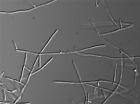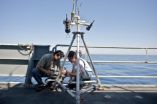(Press-News.org) The GOES-13 satellite has been keeping an eye on Tropical Storm Lisa and watched her birth, graduation to depression then tropical storm and back to depression. Now, Lisa has grown back to tropical storm status, but it may be short-lived.
At 11 a.m. EDT on Friday, Sept. 24, Tropical Storm Lisa had maximum sustained winds near 50 mph and she may strengthen and weaken over the weekend, but by Sunday colder waters will zap her energy source and she is forecast to be a depression.
Meanwhile, on Sept. 24, she was still frolicking in the eastern Atlantic, about 320 miles northwest of the Cape Verde Islands, near 18.9 North latitude and 27.8 West longitude. Lisa was moving north at 7 mph and is expected to turn north-northwest on Sept. 25. Estimated minimum central pressure is 1000 millibars.
The GOES-13 satellite captured a visible image of Tropical Storm Lisa at 16 45 UTC (12:45 p.m. EDT) on Sept. 24. The GOES visible imagery showed that Lisa now has a well-organized center of circulation, which corresponds with infrared and microwave satellite imagery that showed convection has wrapped around three-fourths of the center of circulation.
The infrared data from the Atmospheric Infrared Sounder (AIRS) instrument on NASA's Aqua satellite today showed that Lisa's thunderstorm cloud tops, north of the center of circulation had cooled down to a frosty -80 Celsius (-112 Fahrenheit), one factor that confirms her re-strengthening. The colder the cloud top temperatures, the higher the thunderstorms, and the more powerful they are. When cloud top temperatures cool, it indicates a strengthening storm. When they warm, a storm is weakening.
Over the weekend, Lisa will move into colder waters and the westerly wind shear will increase ahead of an elongated are of low pressure. The wind shear is forecast to be moderate to strong. So strong that they're expected to "decouple" or separate the low-level circulation from the upper-level circulation in the storm causing it to weaken significantly.
Lisa is expected to become a remnant low pressure system by early next week in the eastern Atlantic.
INFORMATION:
GOES-13 Satellite sees Lisa a tropical storm...for now
2010-09-25
ELSE PRESS RELEASES FROM THIS DATE:
The psychology of financial decision-making and economic crises
2010-09-24
How could the current financial crisis have happened? While fingers have been pointing to greedy banks, subprime-loan officers, and sloppy credit card practices, these are not the only contributors to the economic downturn. A new report in Psychological Science in the Public Interest, a journal of the Association for Psychological Science, examines the psychology of financial decision making, including the role of risk in making economic choices, how individuals behave in stock and credit markets, and how financial crises impact people's well-being.
Risk taking is a ...
Microbiologists find source of fungus's damaging growth
2010-09-24
SAN ANTONIO, Texas, U.S.A. (Sept. 22, 2010) – Candida albicans, a fungus that kills more than 10,000 people with weakened immune systems each year, grows more dangerous as it forms and extends long strands of cells called hyphal filaments. In a paper published this month, UT Health Science Center San Antonio microbiologists describe a key factor involved in this damaging growth.
This finding may eventually lead to targets for antifungal strategies, the scientists said.
Patricia Carlisle, a Ph.D. student at the Health Science Center, and David Kadosh, Ph.D., assistant ...
Could brain abnormalities cause antisocial behavior and drug abuse in boys?
2010-09-24
AURORA, Colo (Sept. 22, 2010) Antisocial boys who abuse drugs, break laws, and act recklessly are not just "bad" kids. Many of these boys may have malfunctioning brains, according to a new study by researchers at the University of Colorado School of Medicine.
"Brain responses to everyday rewards and punishments gradually guide most youngsters' decisions to conform with society's rules. However, when these seriously troubled kids experience rewards and punishments, and make decisions, their brains apparently malfunction," said Thomas Crowley, MD, a professor of Psychiatry ...
Clinical trial establishes catheter-based aortic valve replacement as new standard of care for patients
2010-09-24
WASHINGTON, DC (September 22, 2010) -- One-year data from the PARTNER clinical trial, published today in the New England Journal of Medicine, demonstrate that transcatheter aortic-valve implantation, compared with standard therapy, resulted in significantly lower rates of death among patients who cannot undergo surgery for aortic stenosis. The results will be presented tomorrow as a Late Breaking Trial at the 22nd annual Transcatheter Cardiovascular Therapeutics (TCT) scientific symposium.
Transcatheter aortic-valve implantation (TAVI) is a new procedure in which a bioprosthetic ...
Coral bleaching likely in Caribbean this year
2010-09-24
According to the NOAA Coral Reef Watch monitoring system, coral bleaching is likely in the Caribbean in 2010. With temperatures above-average all year, NOAA's models show a strong potential for bleaching in the southern and southeastern Caribbean through October that could be as severe as in 2005 when over 80 percent of corals bleached and over 40 percent died at many sites across the Caribbean. Scientists are already reporting coral bleaching at several Caribbean sites and severe bleaching has been reported from other parts of the world.
The NOAA Coral Reef Watch (CRW) ...
Acute pain is eased with the touch of a hand
2010-09-24
There may be a very good reason that people naturally clutch their hand after receiving an injury. A new report published online on September 23 in Current Biology shows that self-touch offers significant relief for acute pain under experimental conditions. The researchers suggest that the relief comes from a change in the brain's representation of the rest of the body.
"Pain is quite an important, but also complicated, experience and can be caused in many different ways," said Patrick Haggard of University College London. "We show that levels of acute pain depend not ...
Imaging study provides new view of multiple sclerosis
2010-09-24
Scientists have uncovered an alternative source for some of the damage associated with multiple sclerosis (MS), an incurable neuroinflammatory disorder. The research, published online by Cell Press on September 23rd in the journal Immunity, reveals a direct interaction between immune cells and neurons that plays a significant role in neuronal injury and may respond to therapeutic intervention.
MS is an autoimmune disease in which a person's own immune system attacks their central nervous system. Symptoms of MS are variable depending on which nerves are affected, but often ...
African-Americans face kidney disease-related disparities according to 2 new studies
2010-09-24
1. Among HIV-Infected Kidney Disease Patients, African Americans are More Likely to Develop Kidney Failure and Die Prematurely
Washington, DC (September 17, 2010) — Because of improved antiretroviral therapies in recent years, HIV-infected individuals are living long enough to develop chronic conditions. Among African Americans, HIV infection is increasingly recognized as an important risk factor for developing chronic kidney disease. African American men and women are more likely to die from the complications of HIV infection compared with Caucasian men and women. To ...
NIST pair of aluminum atomic clocks reveal Einstein's relativity at a personal scale
2010-09-24
BOULDER, Colo. – Scientists have known for decades that time passes faster at higher elevations—a curious aspect of Einstein's theories of relativity that previously has been measured by comparing clocks on the earth's surface and a high-flying rocket.
Now, physicists at the National Institute of Standards and Technology (NIST) have measured this effect at a more down-to-earth scale of 33 centimeters, or about 1 foot, demonstrating, for instance, that you age faster when you stand a couple of steps higher on a staircase.
Described in the Sept. 24 issue of Science,* ...
Study affirms Gulf oil spill's vastness
2010-09-24
BP’s leaking oil well in the Gulf of Mexico was conclusively sealed this week, but even now, questions remain about the amount of oil that actually came out of it. Initially after the April 20 explosion, officials claimed that the flow could not be measured. Then, as public pressure for information mounted, they looked for ways to measure it, and started producing estimates: at first, 1,000 barrels a day; then 5,000; then 12,000 to 19,000; then upward from there. Now, in the first independent, peer-reviewed paper on the leak’s volume, scientists have affirmed heightened ...



